Glenn Colliver was the caretaker of Mt. Washington Cemetery at the time of Anastasia's murder. He testified about having seen
Anastasia WitbolsFeugen on the afternoon of her murder, having seen her with Justin Bruton later that evening, having spoken to
her father the next morning, and having seen police at the murder scene in Lincoln Cemetery later that same day.
He testified about the location and boundaries of Mt. Washington,(1) and gave some
general information about the William Rockhill Nelson Family Memorial(2). He testified that he had
seen a young woman he identified as Anastasia sitting on the steps of the Nelson Memorial(3) in the
afternoon.
He testified that he saw Anastasia later that evening at the same location, (4)though at that time
she was with a male and near an automobile that he identified as Justin Bruton's.(5)
Mr. Colliver testified that he met Robert WitbolsFeugen, Anastasia's father, the next morning, who told him that his daughter
had not returned home the previous night, and showed him a photograph of her, which he recognized as the girl he had seen the
night before.(6) He testified that when he learned there was a police investigation in
progress at Lincoln Cemetery, he walked over to the cemetery and gave police the information he had received from Robert
WitbolsFeugen.(7)
On cross examination, Mr. Colliver insisted that he had seen the car at the cemetery at 9:00 PM that night,(8)
as opposed to 7:00 PM that Sheriff's Deputies had written down, and continued to insist under recross that the officer had mistakenly written
"1900" (as in military time) instead of "9 PM",(9) although it generally accepted that he was mistaken in that
assertion.(10)
 Q.
Q.